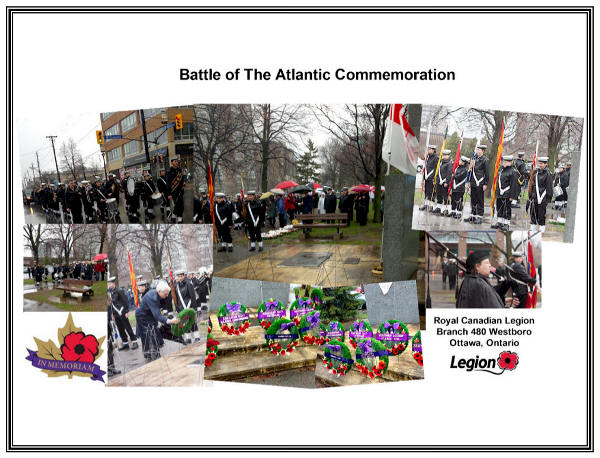|
|
Battle of the Atlantic
Commemoration Ceremony at the branch on May
6th, 2018
 The name "Battle of the Atlantic", coined by
Winston Churchill in 1941, covers a campaign that began on the first day of the
European war and lasted for six years, involved thousands of ships and stretched
over hundreds of miles of the vast ocean and seas in a succession of more than
100 convoy battles and perhaps 1,000 single-ship encounters. Tactical advantage
switched back and forth over the six years as new weapons, tactics and
counter-measures were developed by both sides. The British and their allies
gradually gained the upper hand, driving the German surface raiders from the
ocean by the end of 1942 and decisively defeating the U-boats in a series of
convoy battles between March and May 1943. New German submarines arrived in
1945, but they were too late to affect the course of the war. The name "Battle of the Atlantic", coined by
Winston Churchill in 1941, covers a campaign that began on the first day of the
European war and lasted for six years, involved thousands of ships and stretched
over hundreds of miles of the vast ocean and seas in a succession of more than
100 convoy battles and perhaps 1,000 single-ship encounters. Tactical advantage
switched back and forth over the six years as new weapons, tactics and
counter-measures were developed by both sides. The British and their allies
gradually gained the upper hand, driving the German surface raiders from the
ocean by the end of 1942 and decisively defeating the U-boats in a series of
convoy battles between March and May 1943. New German submarines arrived in
1945, but they were too late to affect the course of the war.
When war broke out, Canadian navy personnel amounted to just 3,684 officers and
crew, including RCN Reserve and Volunteer Reserve.
Within a year, more than 10,000 had mustered in and by 1944, Its numerical
strength peaked at 95,705 officers and men serving in 378 warships. In total,
110,000 men and women served in the RCN during the War, every one of them a
volunteer.
This recruitment represents an amazing fifty-fold in pre-War strength, compared
to a twenty-fold increase of the US Navy, a fourteen-fold increase of the Royal
Australian Navy and an eight-fold increase of the Royal Navy.
The Merchant Navy lost 1,629 Canadians and
Newfoundlanders, or others who served on ships registered in Canada or
Newfoundland. It includes the names of eight women. Many other Canadians, whose
names are unknown, died serving on ships of Allied merchant navies. Also, 198
Canadian seamen were taken prisoner when their ships were captured or sunk,
often in the very early years of the war. Many spent more than four years
interned and eight died as prisoners of war or during repatriation.
|

HMCS Ottawa |
|
Navy |
The Royal
Canadian Navy |
|
Type |
Destroyer |
|
Class |
C |
|
Pennant |
H 60 |
|
Built by |
Portsmouth Dockyard (Portsmouth,
U.K.): Hawthorn Leslie & Co. (Hebburn-on-Tyne,
U.K.) |
|
Ordered |
13 Feb 1930 |
|
Laid down |
12 Sep 1930 |
|
Launched |
30 Sep 1931 |
|
Commissioned |
15 Jun 1938 |
|
Lost |
14 Sep 1942 |
|
Loss position |
47° 55'N, 43° 27'W |
|
The RCN lost 1,965 men and
24 ships during the
War, most of them in the Atlantic.
One of those ships was the destroyer
HMCS Ottawa
At 02.05 hours on 14 September 1942 the German submarine U-91 fired a spread of
two torpedoes at a destroyer and observed a hit. Then they saw another
destroyer, made a full circle and fired at 02.15 hours one torpedo, which hit
amidships and caused the ship to blow up and sink immediately.
Walkerling
thought that they had sunk two destroyers, but in fact HMCS Ottawa (A/Lt.Cdr.
Clark Anderson Rutherford, RCN), escorting convoy ON-127, was hit twice and sank
in position 47º55'N, 43º27'W (German naval grid BC 6191) with the loss of 113
crew. There were 67 survivors.
They shall grow not old, as we that
are left grow old:
Age shall not weary them, nor the years condemn.
At the going down of the sun and in the morning,
We will remember them.
|